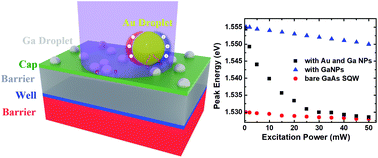Plasmonically-powered hot carrier induced modulation of light emission in a two-dimensional GaAs semiconductor quantum well†
Abstract
A hot-electron-enabled route to controlling light with dissipative loss compensation in semiconductor quantum light emitters has been realized for tunable quantum optoelectronic devices via a two-species plasmon system. The dual species nano-plasmonic system is achieved by combining UV-plasmonic gallium metal nanoparticles (GaNPs) with visible-plasmonic gold metal nanoparticles (AuNPs) on a near-infrared two-dimensional GaAs/AlGaAs quantum well emitter. It has been demonstrated that while hot carrier-powered charge-transfer processes can result in semiconductor doping and increased optical absorption, photo-generated carrier density in the quantum well can also be modulated by off-resonant plasmonic interaction without thermal dissipation. Merging these essential emitter-friendly optical characteristics in the two-species plasmon system, we effectively modulate the frequency of the emitted light. The wavelength of the emitted light is tuned by the plasmonically powered hot electron process induced by the AuNPs with a 10-fold emission enhancement induced by the GaNPs. The additional plasmonic element provides functionality to achieving an active plasmonic light emitter that is otherwise far from reach with conventional single plasmonic material-based semiconductors.



 Please wait while we load your content...
Please wait while we load your content...